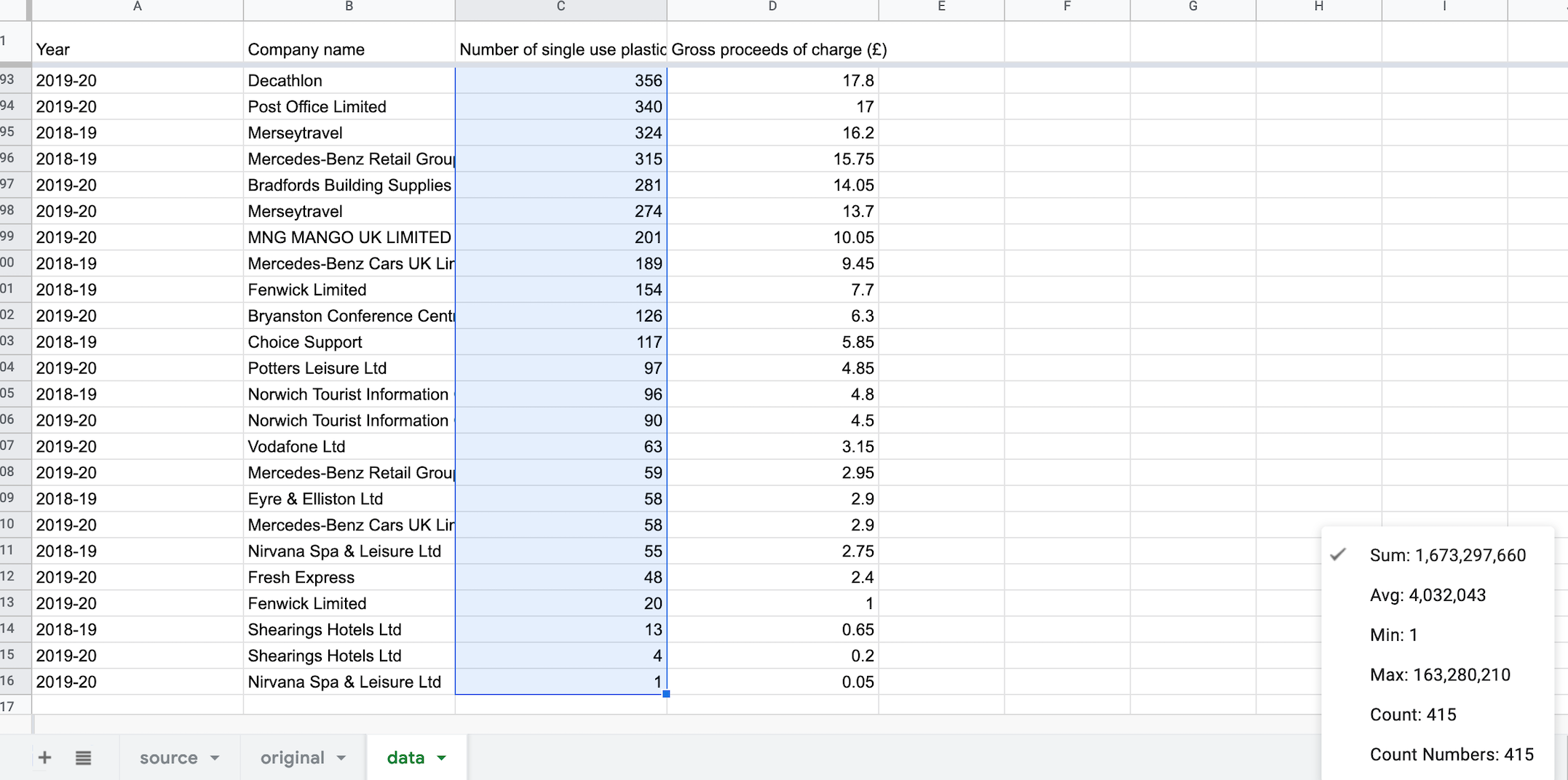WALKTHROUGH: Get a CSV file into a spreadsheet
Background. Since 2015, shoppers in England have had to pay a 5p levy for single-use plastic bags (except for smaller shops). This was increased to 10p in May 2021 and extended to all shops. Larger retailers not only have to charge customers but must also collect data on the numbers of bags given to customers, the money collected and what they did with the money. The steps below walk through how to get some of this data into a spreadsheet and start to analyse it.
- Higher plastic bag charge comes into force in England (BBC)
- Government guidance to retailers on carrier bag charges
IMPORTING YOUR FILE
Download the following CSV file to your computer: bags_2years.csv
Once the file is on your computer, right-click on it and, under Open With, choose the Text Edit or Notepad programme to look at what’s actually in the file.
It’s a bit of a jumble but you can see that all the pieces of information are separated by commas:

Now that you’ve seen what’s inside your file, close it and navigate to a Google Drive online
Open a new Sheet by clicking + New, then Google Sheets, then Blank Spreadsheet

In the new Sheet, click on the Untitled Spreadsheet box on the top left and give your Sheet a name
Under File select Import, then Upload
Choose your bags_2years.csv file from your computer
If asked in a dialogue box about Import Location, select Insert New Sheet and for Separator Type, choose Comma or Detect Automatically
You should now have the data from the CSV file in your Google Sheet:

ORGANISING YOUR SHEET
Adjust the width of the four columns (Widen or narrow by dragging the row containing the column letter names: A, B, C etc.). There are several data types here and numbers are aligned on the right, while text is aligned on the left.
In the bottom left, your sheet will have a tab called bags_2years. Right click on the tab and select Duplicate. This will generate a copy of your Sheet with a tab entitled Copy of bags_2years. Double click on this tab and rename it as data.

Add another Sheet by using the + button just to the left of the tabs. Give this sheet the name Source and somewhere in the sheet paste the following url, which is the where the data in your CSV file came from:
- https://data.gov.uk/dataset/682843a8-168c-4056-b6fe-741161a39f60/single-use-plastic-carrier-bags-charge-data-for-england
THE DATA
At this point we have imported the CSV file to a Sheet, we have named the Sheet and we have duplicated it so that we have a copy of our data if we need it. We’ve also added the source for the data so that if we come back to work on this in six months we’ll know where the data came from.
Our data has four columns:
- Year
- Company name
- Number of single-use plastic bags issued
- Gross proceeds of charge
It shows how many single-use plastic bags each major retailer issued in England in 2018-19 and 2019-20, and how much money each collected from charging customers for the bags. The data was published in 2020 by the Department for Environment, Food and Rural Affairs (DEFRA).
NAVIGATING THE SHEET
Under the menu View, choose Freeze then 1 row. This will keep the column names in place as you scroll down through the sheet.

Use CMD and a down arrow to jump to the bottom of the dataset. Use CMD and a right arrow to jump to the right of the dataset and so on.
Use CMD and SHIFT and arrows to select all the cells when you jump to the edge of the dataset.
Select all the cells in Column B (‘Company Name’). On the bottom right the Sheet will automatically supply a Count of the cells that contain information.

If you select all the cells in Column C (‘Number of single-use plastic bags issued’) that have numbers, there will be numerical calculations in the bottom right and not simply a count of the number of cells.

Adjust the number of decimal points showing in Column D (‘Gross proceeds of charge’) by using the Increase / Decrease Decimal Places buttons

SORT & FILTER
Select any cell in your data. In the menus, go to Data and choose Create a filter

Now you can filter a column and select, for example, only the 2019-20 rows

Go back to Data and choose Remove filter
Beside the letter of each column (A, B, C etc.), there is a hidden triangle with a drop down menu. Clicking on this lets you select Sort A-Z or Sort Z-A. You can sort all the company names alphabetically. Or you can sort a column of numbers from the biggest to the smallest. Sort the Company Name column alphabetically.

Try sorting the ‘Number of single-use plastic bags issued’ column to see what company charged for the biggest (or smallest) number of bags over the two years.
MORE
The learning platform GCF has more tutorials (sections 8-16) on the steps above.